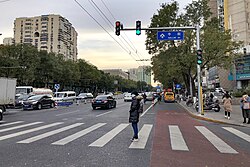This article relies largely or entirely on a single source. (January 2014) |
Niujie Subdistrict
牛街街道 | |
|---|---|
 North start of Niujie in 2020 | |
| Coordinates: 39°53′11″N 116°21′48″E / 39.88639°N 116.36333°E | |
| Country | China |
| Municipality | Beijing |
| District | Xicheng |
| Area | |
• Total | 1.44 km2 (0.56 sq mi) |
| Population (2020) | |
• Total | 51,410 |
| • Density | 36,000/km2 (92,000/sq mi) |
| Time zone | UTC+8 (China Standard) |
| Postal code | 100053 |
| Area code | 010 |
Niujie (Chinese: 牛街; pinyin: Niú jiē; Wade–Giles: Niu-chieh; lit. 'Oxen Street[1]') is a subdistrict in Xicheng District in southwest Beijing, China.[2] The name "Niujie" can refer to the street Niujie or to the neighborhood Niujie.[3] The subdistrict was previously in Xuanwu District before the district was merged into Xicheng District in 2010. As of 2020, its total population is 51,410.[4]
The Niujie Subdistrict is administered by the Niujie Subdistrict Administrative Office. The core area of this district is along the street Niujie.[1] The Niujie core area, a Hui people neighborhood,[5] has Beijing's largest concentration of Muslim people.[2] As of 2013 there is a Muslim-oriented hospital as well as social services, cafés, shops, restaurants, and schools catering to the Muslim population.[6] In 2002 Wenfei Wang, Shangyi Zhou, and C. Cindy Fan, authors of "Growth and Decline of Muslim Hui Enclaves in Beijing," wrote that Niujie "continues to thrive as a major residential area of the Hui people in Beijing and as a prominent supplier of Hui foods and services for the entire city."[5] The neighborhood has the Niujie Mosque, which according to Wenfei Wang, Shangyi Zhou, and Cindy Fan, "mark[s] the identity of Niujie" and has an element of centrality in the community.[7] Most larger Hui neighborhoods in Beijing have their own mosques.[3]
- ^ a b Wang, Zhou, and Fan, p. 112.
- ^ a b "Culinary delights: Beijing's Muslim cuisine." (Archive) China Internet Information Center (China.org.cn). Retrieved on 5 January 2014.
- ^ a b Wang, Zhou, and Fan, p. 113.
- ^ 国家统计局, ed. (2020). 中国统计年鉴 [China statistical yearbook]. Vol. 39 (1st ed.). Beijing: 中国统计出版社. ISBN 978-7-5037-9225-0. OCLC 1262741013.
- ^ a b Wang, Zhou, and Fan, p. 104.
- ^ Wu, Weiping and Gaubatz. p. 254.
- ^ Wang, Zhou, and Fan, p. 117.

